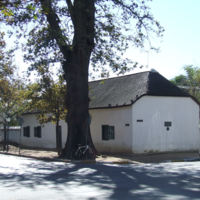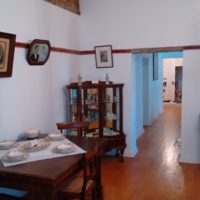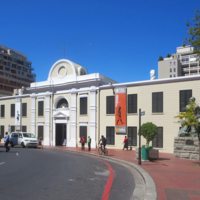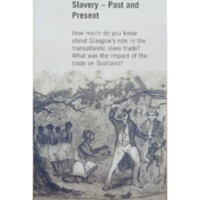
Stellenbosch Village Museum
Stellenbosch Village Museum is one of 28 museums affiliated with the Western Cape Provincial Government’s Museum Service. The Village Museum consists of four period houses dating from the early eighteenth century to the Victorian era. It opened during the 1970s as part of what was then a larger complex of museums in Stellenbosch. The museum was partially redeveloped by Museum Service staff in 2015, with new exhibition panels and an interactive historical timeline installed in the foyer area. Focus is given to the historical origins of Stellenbosch with attention given to a diverse range of historical actors, from the enslaved to Khoi people. This is an important part of moving historical interpretation at the Village Museum away from the whites-only affair established in the apartheid years. Artefacts uncovered during excavations of the period houses and their outbuildings are displayed, though these lack contextual information in places.
Slavery is not referred to in great detail in the exhibition panels, however it does feature on the interactive timeline. Both the abolition of the slave trade in 1807 and abolition of slavery in 1834 are referenced. Efforts are made to posit the Bletterman family – original owners of the Village Museum’s late eighteenth century property - as slave owners. Particular attention is given to the case study of the enslaved woman Manisa who was owned by Stellenbosch resident Johanna Barbara van Biljon. This focus comes from the unusual level of surviving material which enabled a reconstruction of Manisa’s life, including separation from her family through public auction. There is even a full body portrait of Manisa, taken from a Cape Argus article published upon emancipation. Problematically, one of the outbuildings of Bletterman House which potentially functioned as slave quarters has been rented out by the museum and presently houses a number of eateries. No connection is made between references to the outbuildings as slave quarters in the historical timeline and their present use.

Pniel Museum
Pniel Museum is a small community-run museum which opened in 2013 in the village of Pniel, close to Stellenbosch. It has its roots in a long-running project, dating back to the unveiling of the Freedom Monument on the werf area of the former Papier Moelen manor house (which now houses the museum) in 1993. Pniel itself is a former Apostilic Union mission station which was established in 1843. Many of its early inhabitants were purportedly enslaved people looking for somewhere to settle following the ending of the five year apprenticeship period in 1839. It was designated a rural coloured group area under apartheid. A small group of locals have a clear sense of pride in their history, and embrace their connections with slavery which is taken as Pniel’s formative experience. The Freedom Monument – which celebrates emancipation – was reflective of this, and subsequent developments including two further monuments and the museum have advanced this engagement with the past. The museum itself offers a thorough overview of local history, partially laid out in the form of a historical farmhouse, and partially based on interpretive content. There is no exhibition dedicated to slavery at Pniel Museum, however the links between Pniel and slavery are evident at various points. Additionally, staff (local volunteers) are happy to talk about the links both they and Pniel hold with slavery. Perhaps the most important display in terms of slavery is a family tree of the Willemse family. At the top sits a photograph of Adriaan Willemse who is described as ‘a freed slave who settled on the Pniel mission station and became the father of almost 70% of Pniel inhabitants’. The museum functions as something of a community archive featuring donated objects ranging from cutlery to trade implements. There are, however, no objects which belonged to the village’s early and formerly enslaved inhabitants.

Slave Lodge
The Slave Lodge building was first constructed in 1679 by the VOC as housing for the people they enslaved. It was modified over time, and post-British settlement of the Cape was transformed into government offices. After passing through various stages of administrative use – most notably as the Supreme Court – it opened as the South African Cultural History Museum in 1967.
Typical of apartheid-era museology, its displays made no reference to the building’s connections with slavery. Post-apartheid, the museum was brought under the management of southern state umbrella Iziko Museums, and was renamed Slave Lodge in 1998. Although a number of its displays still date from the Cultural History Museum period, new exhibitions have been installed, and the museum now purports to serve as a centre where human rights abuses are discussed and exposed. There is a particular focus on slavery, and racial segregation under apartheid, both through permanent and temporary displays.
The main slavery exhibition is titled ‘Remembering Slavery’ and opened in 2006. This occupies the western wing of the ground floor of the museum. The exhibition offers a comprehensive overview of Cape slavery, with galleries focussing on contextual history, the Slave Lodge building, the middle passage, slave trading routes in the Indian and Atlantic Oceans, and a recreation of life in the eighteenth century Slave Lodge. Owing to the paucity of material remnants of slavery at the Cape, the exhibition relies on text to a large extent. Tapping in to the ‘reconciliation’ narrative of the early Mandela years, its overall effect is to portray slavery as a South African history which the country has learned from.
The opposite wing of the building hosts a changing selection of temporary exhibitions which have focussed on human rights abuses including the anti-apartheid struggle and women’s rights. The museum offers a comprehensive education programme with a particular focus on slavery.

Towards Understanding Slavery: Past and Present
The Towards Understanding Slavery: Past and Present initiative by Glasgow City Council aimed to increase understanding of the human effects of the transatlantic slave trade, and explore its impact on Scotland's national heritage and Glasgow's history. A series of events, exhibitions and education programmes ran across the city throughout 2007. These included an exhibition of William Blake's works relating to the idea of slavery at the Burrell Collection, and a photographic exhibition by Graham Fagen, 'Downpresserer', at the Gallery of Modern Art, examining the cultural heritages of Scotland and Jamaica. There was a series of performances and talks at Kelvingrove Art Gallery and Museum, and events at the People's Palace and Winter Gardens focused on links between Glasgow's tobacco trade and slavery through the family portrait of the 'tobacco lord' John Glassford (there is said to be a figure of a young black man behind Glassford's chair that has been deliberately obscured or painted over). A year-long programme of lectures, schools events and exhibition highlighting the life of African communities in Glasgow took place at St Mungo Museum of Religious Life and Art.